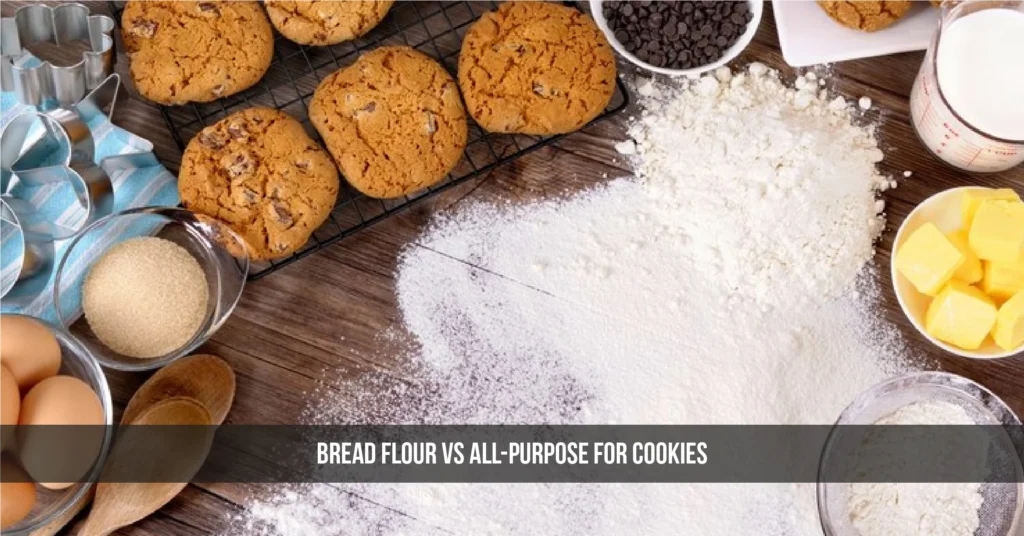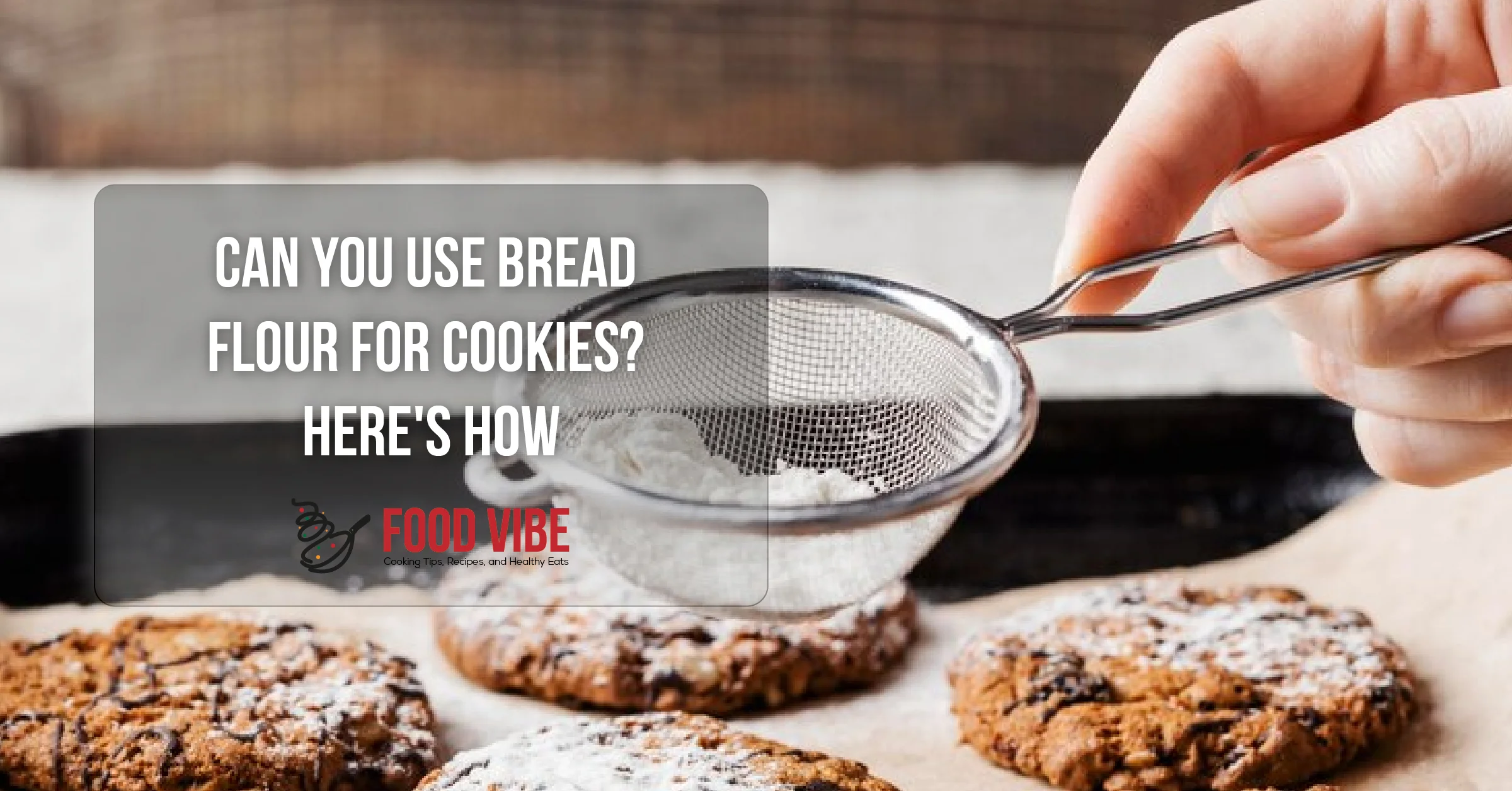Can You Use Bread Flour for Cookies? Here’s How
Want to take your baking to the next level? Try using bread flour for cookies. It brings a new world of textures and tastes. Home bakers often use all-purpose flour, but bread flour is becoming a favorite.
Bread flour’s high protein content makes cookies chewy and structured. Curious about using bread flour in your cookies? This guide will show you how to make it work.
Table of Contents
Understanding Bread Flour
Many people ask, “What is bread flour?” It’s made from hard wheat, known for its high protein content. This protein is between 12% to 14%. It’s key for making bread chewy.
What is Bread Flour?
Bread flour is special because of its high protein. It’s a must-have for bread making. It makes the dough elastic and strong, helping it rise well.
Unlike all-purpose flour, bread flour is milled differently. This makes it perfect for bakers who want specific results in their bread.
Texture and Protein Content
The texture and protein in flour affect more than just bread. They also impact cookies and other treats. Bread flour’s denser grain makes cookies chewier.
This is great for achieving a satisfying texture in your baked goods. Knowing how flour texture and protein content work in your recipes can improve your baking.
Why Use Bread Flour for Cookies
Using bread flour in your cookie recipes can really improve your baking. It makes your cookies chewier and better overall.
Chewier Cookie Texture
Bread flour has more gluten than all-purpose flour. This gluten makes your cookies chewier. When you eat them, you’ll love the chewiness.
The gluten also helps the dough rise and stay moist. This makes your cookies denser and chewier.
Adding Structure to Your Cookies
Bread flour also makes your cookies more structured. It helps them keep their shape while baking. This is great for cookies that spread too much with all-purpose flour.
With bread flour, your cookies will be thick and perfectly shaped. They’ll have a great chewiness and structure, making them stand out.
Types of Bread Flour
Knowing the different types of bread flour is key to better baking. The main difference is between all-purpose flour and bread flour. They vary in protein content and what they’re best for in recipes.
All-Purpose vs Bread Flour
All-purpose flour has about 10-12% protein. It’s good for many baked goods, like cookies and cakes. On the other hand, bread flour has 12-14% protein. This means it makes baked items chewier and more elastic.
Choosing between all-purpose and bread flour depends on the cookie’s texture you want. Bread flour makes cookies sturdier and denser. All-purpose flour is better for lighter cookies.
Specialty Bread Flours
There are also specialty bread flours that can add unique flavors and textures. Whole wheat flour, for example, adds a nutty taste and a denser crumb. Sourdough flour gives a tangy flavor and character.
These specialty flours offer rich flavors and health benefits. They can change your baking game. Trying them out can lead to cookies with more depth and complexity.
Bread Flour vs All-Purpose for Cookies
It’s important to know how bread flour and all-purpose flour differ in baking. Each type affects the cookie’s spread, rise, and texture. This knowledge helps you get the cookie you want.
Differences in Baking Performance
Bread flour makes cookies chewier because it has more protein. This is great if you like cookies with more body. All-purpose flour, however, makes cookies spread more evenly. It’s up to you whether you prefer chewy or soft cookies.
Flavor and Texture Comparisons
Bread flour gives cookies a richer taste. It keeps them moist, making them denser. All-purpose flour, on the other hand, has a lighter taste. It’s better for classic cookies.
| Flour Type | Baking Performance | Flavor Profile | Texture |
|---|---|---|---|
| Bread Flour | Chewy, holds shape well | Robust, hearty | Dense, structured |
| All-Purpose Flour | Balanced spread and rise | Lighter, versatile | Soft, delicate |

How to Use Bread Flour for Cookies?
Using bread flour in your cookie recipes can lead to exciting new textures and flavors. To achieve the best results, you must focus on adjusting cookie recipes and employing effective mixing techniques for cookies. This section provides key insights to help you navigate the transition to bread flour effortlessly.
Adjusting Your Cookie Recipes
When you decide to use bread flour, adjusting cookie recipes becomes essential to compensate for its higher protein content. Start by reducing the amount of liquid in your recipe, as bread flour absorbs moisture differently than all-purpose flour. Typically, a reduction of about 10-15% works well.
- Consider decreasing the egg quantity for softer cookies.
- Incorporate additional fat such as butter or oil to enhance tenderness.
- Experiment with baking times, as cookies may require slightly longer due to the chewy texture of bread flour.
Mixing Techniques for Best Results
Understanding mixing techniques for cookies is crucial when using bread flour. The method of mixing can impact the final product significantly. Here are some effective techniques:
- Start by creaming the butter and sugar until light and fluffy. This incorporates air, which is vital for leavening.
- Add your eggs one at a time, fully incorporating each before adding the next.
- Gradually add the dry ingredients, mixing just until combined. Overmixing can lead to tough cookies.
Following these adjustments and techniques will help you create delicious cookies with the uniqueness that bread flour offers. Enjoy experimenting and see how these changes elevate your baking game.

Cookie Recipes With Bread Flour
Ready to take your baking to the next level? Try using bread flour in your cookie recipes. You’ll get amazing results. Enjoy chewy chocolate chip cookies and a unique oatmeal cookie twist.
Classic Chocolate Chip Cookies
This recipe uses bread flour for a chewy texture. It’s perfect with gooey chocolate chips.
- 2 ¼ cups bread flour
- 1 tsp baking soda
- ½ tsp salt
- 1 cup unsalted butter, softened
- ¾ cup granulated sugar
- ¾ cup brown sugar, packed
- 1 tsp vanilla extract
- 2 large eggs
- 2 cups chocolate chips
Preheat your oven to 350°F (175°C). Mix the bread flour, baking soda, and salt in a bowl. Cream the butter and sugars in another bowl. Add vanilla and eggs, then mix in the dry ingredients and chocolate chips. Drop spoonfuls on a baking sheet and bake for 10-12 minutes.
Oatmeal Cookies with a Twist
Try oatmeal cookies with a twist. This recipe adds nuts and dried fruits for extra flavor.
- 1 ½ cups bread flour
- 1 tsp baking powder
- ½ tsp baking soda
- ½ tsp salt
- 1 cup unsalted butter, softened
- ¾ cup brown sugar, packed
- ½ cup granulated sugar
- 2 large eggs
- 3 cups rolled oats
- 1 cup chopped nuts (walnuts or pecans)
- 1 cup dried fruits (raisins or cranberries)
Start by preheating your oven to 350°F (175°C). Mix the flour, baking powder, baking soda, and salt in one bowl. Cream the butter and sugars in another bowl. Add eggs, then mix in the dry ingredients, oats, nuts, and dried fruits. Drop spoonfuls on a baking sheet and bake for 12-15 minutes.
These cookie recipes with bread flour will satisfy your sweet tooth. They’ll also impress everyone who tries them. Enjoy the rich flavors and textures.
Best Practices for Baking with Bread Flour
When baking with bread flour, following best practices is key to great results. Proper measuring and storing are crucial. This section covers important tips for measuring and keeping your bread flour fresh.
Measuring Your Ingredients Accurately
Getting your ingredients right is crucial in baking. A kitchen scale is best for accurate measurements. It avoids the errors that come from packing flour into cups.
Fluffing the flour before measuring helps. Then, use a straight edge to level it off. A digital kitchen scale is a reliable choice for precise results.
- Always fluff the bread flour before measuring to aerate it.
- Spoon the flour into the measuring cup and level it off with a straight edge.
- Invest in a digital kitchen scale for reliable results.
Storing Bread Flour Properly
Keeping bread flour fresh is important. Air can cause it to spoil or pick up bad smells. Here are some tips for storing bread flour:
- Use airtight containers to protect against moisture and pests.
- Store flour in a cool, dry place, away from direct sunlight.
- For long-term storage, consider refrigeration or freezing.
| Storage Method | Benefits | Duration |
|---|---|---|
| Airtight Containers | Prevents moisture and pests | Up to 6 months |
| Cool, Dry Place | Mantains freshness and texture | Up to 1 year |
| Refrigeration/Freezing | Extends shelf life significantly | 1 year or more |
By following these best practices, your baking with bread flour will always be a success. Your cookies will show the quality of your work and ingredients.

Where to Buy Bread Flour for Cookies
Finding the right place to buy bread flour for cookies can make a big difference. You can choose from local grocery stores, specialty shops, or online markets. Knowing where to find quality bread flour is key to perfecting your cookie recipes.
Local Grocery Stores and Specialty Shops
Local grocery stores like Kroger, Safeway, and Walmart usually have bread flour. Specialty shops offer unique types that might be perfect for certain recipes. Shopping in these places lets you explore different flours and get advice from experts.
Online Options for Convenience
Online shopping is a great way to buy bread flour. Sites like Amazon and Bob’s Red Mill have a wide selection, including organic and specialty flours. You can easily compare prices and brands, making it easy to find the best one for your baking. This is perfect for those who are short on time or prefer shopping from home.
Conclusion
Using bread flour for cookies can really improve your baking. The extra protein in bread flour makes cookies chewier. This is a big plus for many cookie fans.
By adding bread flour, you make your cookies not just tasty but also better in texture. This can make your baked goods even more enjoyable.
Trying bread flour in your cookie recipes can lead to great results. It’s perfect for both classic and new recipes. Experimenting with it can make your cookies more exciting.
So, the benefits of bread flour in cookies are clear. We suggest you try it out. You might be amazed at how it can make your cookies chewy and delicious.
Also Read: Oil-Free Cooking: Delicious Ways to Cook Without Oil
FAQs
What makes bread flour different from all-purpose flour for cookies?
Bread flour has a higher protein content (12-14%) compared to all-purpose flour, which gives cookies a chewier texture and more structure.
Can I substitute bread flour for all-purpose flour in any cookie recipe?
Yes, but you may need to adjust the liquid content and mixing techniques to account for bread flour’s higher protein and moisture absorption.
What types of cookies work best with bread flour?
Bread flour is ideal for cookies where a chewy texture is desired, such as chocolate chip cookies or oatmeal cookies with added nuts and dried fruits.
How should I store bread flour to keep it fresh?
Store bread flour in an airtight container in a cool, dry place, or refrigerate/freeze it for long-term storage to maintain freshness.
Where can I buy bread flour to bake cookies?
Bread flour is available at local grocery stores, specialty baking shops, and online retailers like Amazon or Bob’s Red Mill for convenience and variety.














Post Comment